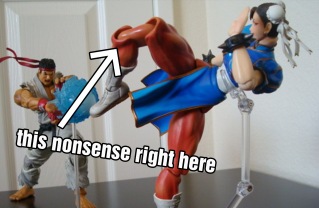The main body has been blocked in, so I’m now working my way back up with some additional detail. Starting at the feet, I made my way up the knees with some more concrete design work. I’ve also been fleshing out a lot of the specifics of construction.

The feet have taken some work. I had a general idea of what they were supposed to look like, but they were admittedly not my biggest focus when creating the concept. I’m probably going to be doing a few follow-up concept pieces throughout the build to get a better sense of the details. For right now, though, I like the idea of bringing in some elements of trail shoes to this robotic foot design. It also made me start thinking about different materials I could use when casting the final pieces. I want to look at what’s available, but doing the soles of the feet and other parts out of a flexible rubber would really give the final piece some extra flair.
—————————————–
I’m trying something new with the knee design to solve a problem that most likely no one else is really bothered by. I’ve always found it a bit awkward how so many figures on the market use a traditional double-knee joint. Many Play Arts Kai figures, for example, use a ridiculously over-sized joint, which makes for weird poses when bending the knee.

I’ve also had the experience that when you bend the leg, usually one joint will bend all the way before the other starts bending. So, in an attempt to fix that noise, I’m adding geared teeth onto the joints to ensure the leg bends evenly every time. It’s most likely over-engineering for such a minor issue, but this is my project, dammit, and it will be meet my expectations.
 I had gone through a few different versions of implementing this idea. The last had exposed teeth on the joint, and although it was simpler, I hated the idea of being able to see the inner workings of a detail that should be invisible. Currently, it’s fairly similar to many of the double joints other figures use, just hollowed out to make room for the teeth on the inside. I will most likely be prototyping this piece next. I plan on trying a few different gear ratios. Right now it’s set up for two gears of the same size, but I think one large and one small gear may actually give a more realistic result. Looking at the way a knee bends, the kneecap appears to stay in line much more with the shin than the thigh. To achieve this effect, I think I’ll need a small gear for the top joint and a larger one for the bottom. More to come as this develops.
I had gone through a few different versions of implementing this idea. The last had exposed teeth on the joint, and although it was simpler, I hated the idea of being able to see the inner workings of a detail that should be invisible. Currently, it’s fairly similar to many of the double joints other figures use, just hollowed out to make room for the teeth on the inside. I will most likely be prototyping this piece next. I plan on trying a few different gear ratios. Right now it’s set up for two gears of the same size, but I think one large and one small gear may actually give a more realistic result. Looking at the way a knee bends, the kneecap appears to stay in line much more with the shin than the thigh. To achieve this effect, I think I’ll need a small gear for the top joint and a larger one for the bottom. More to come as this develops.
-Nick